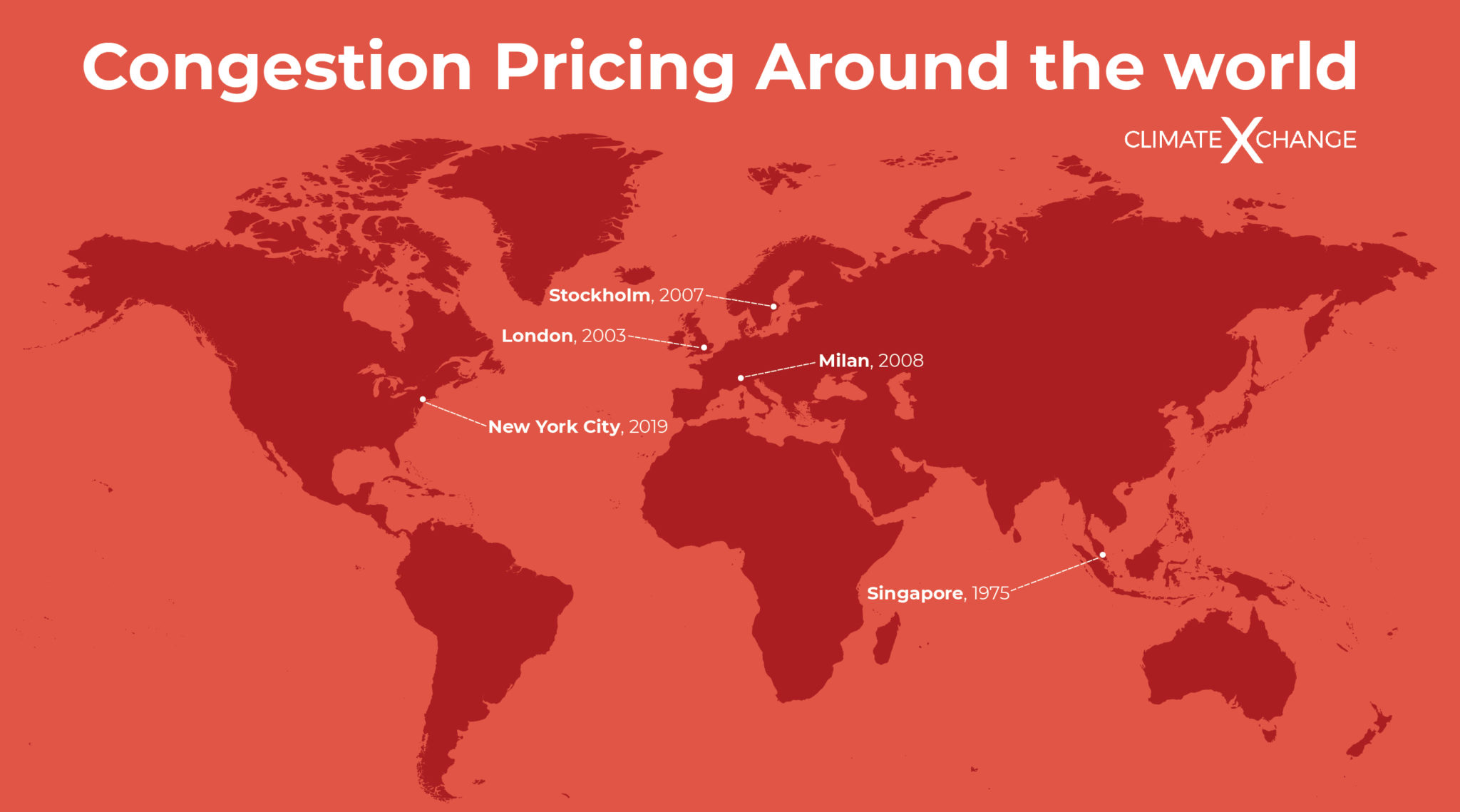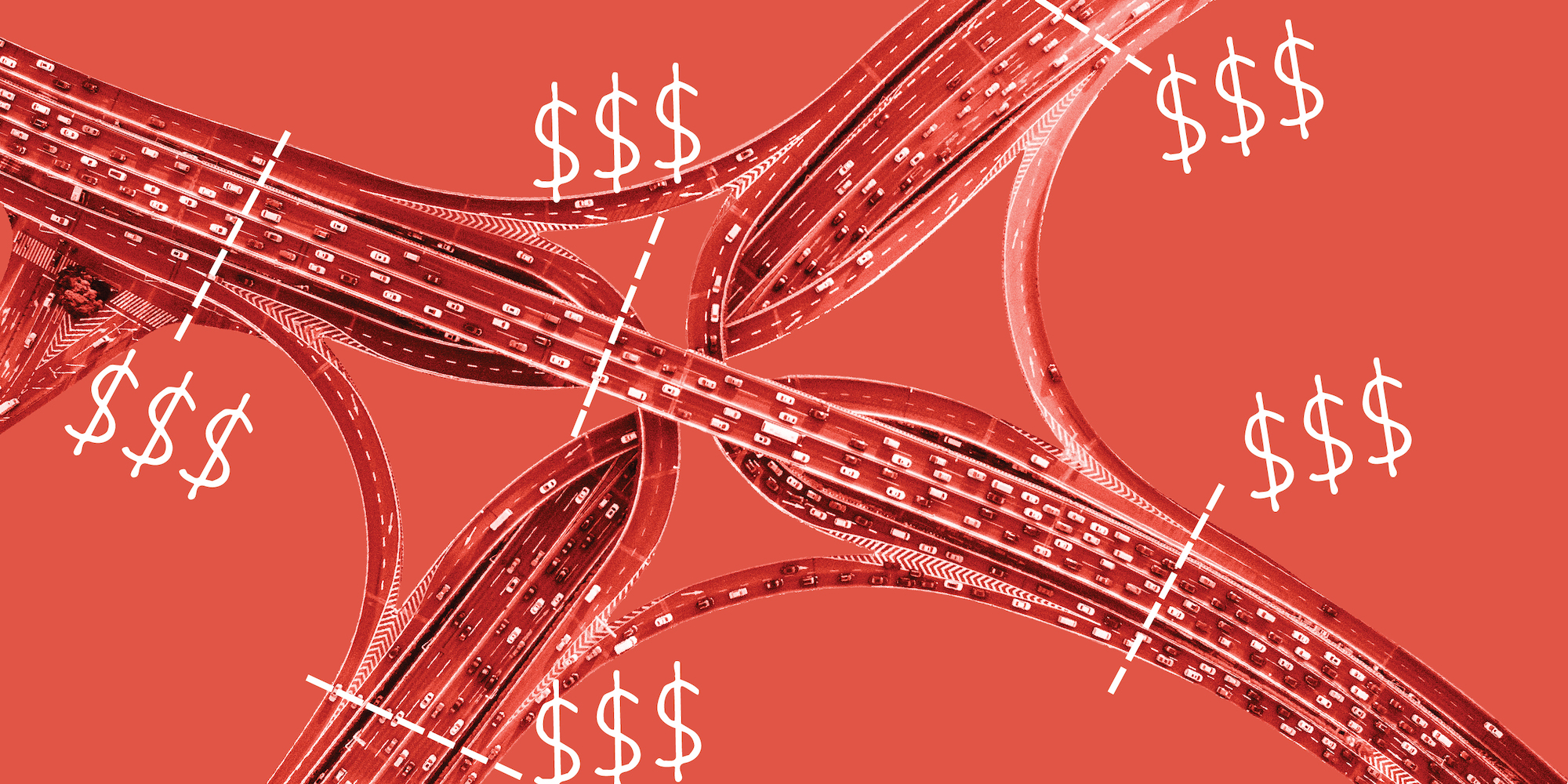Besides the weather, traffic is probably the one thing we can all find in common to talk – or rather complain – about. Traffic during commuting times affects the health, well-being, and employment opportunities for millions of Americans living in or around urban areas. And it’s a problem that seems to only be getting worse. Can traffic be fixed? Or are we doomed to spend more and more time in our cars every day?
It’s not just our time that takes a hit from traffic. Carbon and local pollutant emissions also rise due to heavy traffic. These emissions have been linked to climate change, but also to local health effects like asthma and cancer. This means that it’s not just people behind the wheel who are dealing with the consequences of traffic, but also those living around highways or highly congested roadways.
Congestion charges are a way to tackle these problems simultaneously, and have been successful in different cities around the world. They are a dynamic toll with a charge that rises and falls due to the demand on that particular road at a particular time. These tolls are not designed to raise funds, but rather to make it costlier for people to utilize roads during peak hours so cars can travel closer to intended speeds for those roadways. However, programs like these can provide funds to subsidize public transportation, and therefore provide more effective and reliable options for those who will, ideally, no longer be driving.
What is Congestion Pricing?
With the number of cars on the road increasing at a rate that far outpaces infrastructure expansion, cities and urban centers are more congested than ever. The average commuting time is on the rise around the world, with severe economic implications. Last year, the average American driver lost 97 hours of their time to traffic, costing the national economy $87 billion in lost productivity. With traffic congestion posing an enormous economic and environmental threat, there is a need to find creative ways to address this issue while improving transportation options for commuters.
Although it may first seem like an obvious solution, expanding infrastructure and roads actually has a counterproductive effect on traffic congestion because larger roads attract commuters who would not have been inclined to travel by private car previously. Increasing road capacity, therefore, only serves to recruit new drivers, creating a vicious cycle. After many unsuccessful attempts to increase capacity on traffic-plagued roadways, such as the Big Dig in Boston, which doubled commute times in some parts of the state, innovative market solutions are being examined with greater urgency.
In March of 2019, New York became the first major US city to adopt their own form of congestion pricing (Virginia has had a form of congestion pricing for drivers traveling alone into D.C. since 2017). Other cities that have implemented such a fee, including London and Singapore, have achieved the desired impact within months and proponents claim it to be one of the most effective ways to deal with congestion in urban areas, as well as carbon emissions reductions. When London began imposing a congestion fee in 2012, traffic was reduced by 30% within the first year. However, congestion pricing is not just a way to reduce traffic in major cities, it can also serve the goal of reducing carbon emissions in urban areas, where they are highest. Transportation contributes 30% of global CO2 emissions and the majority of that is from road transport. Congestion pricing policies lead to fewer cars on the road and, consequently, less emissions.
The revenue levied from these programs is also used to invest in public transportation, making it cleaner, faster, and more efficient, while expanding its accessibility and reducing the price of fares. This incentivizes more individuals to take advantage of public transportation, which also leads to a significant decrease in carbon emissions.
A Global History of Congestion Pricing

While New York may be the first city in the United States to implement a form of congestion pricing, this is hardly a new phenomenon. Cities from around the world have been introducing their own form of this policy for decades, and the economic theory of congestion pricing has been around since the mid 20th century. In practice, it has been utilized in some capacity for over 40 years. Here is a look at some of the cities already doing this.
Singapore
In 1975, Singapore became the first city to implement a form of congestion pricing. It was known as the Singapore Area Licensing Scheme and was introduced to reduce traffic congestion in the Central Business District (CBD). A charge was imposed on vehicles driving during morning peak hours, Monday through Saturday between 7:30am and 9:30am. This toll took the form of a special license all cars entering the CBD had to buy in order to enter, for the price of $3 per day or $60 per month. Alternatively, residents could park their vehicles in lots on the outskirts of the city for a cost of $10 per month and shuttle in to the CBD for $0.50 each way. This scheme remained in effect until 1998, when it was replaced by the Electronic Road Pricing system. Singapore was the first city to introduce electronic road pricing, in which toll payment becomes automatic. Gantries are installed at every roadway leading into the city center and automatically charges the driver via a pass installed on the windshield which has stored credit. The price of the tax fluctuates throughout the day based on peak travel times. This system is still in effect in Singapore today.
London, England
In 2003, London followed Singapore by becoming the second major city to implement their own form of congestion pricing. Their system, known as the London Congestion Charge, takes the form of a fee imposed on vehicles in the Congestion Charge Zone between 7:00am and 6:00pm Monday through Friday. The standard charge for non-exempt vehicles is £11.50 today, having begun at £5.00 in 2003. Residents living within the charge zone are eligible for a 90% discount. Enforcement for payment of this fee is primarily based on Automatic Number Plate Recognition, in which a camera registers the license plate of the vehicle entering the congestion zone and automatically charges the driver.
London has seen remarkable results since beginning this program. Within a year of implementing the fees, traffic delays went down 30% and the average speed of vehicles in the zone rose to 10 miles per hour from 8.8 m.p.h. In the first 10 years that the charge was in effect, they levied £2.6 billion and invested half of this in public transport, road and bridge improvement, and walking and cycling initiatives. London also experienced a significant improvement in their air quality, with a 12% reduction in emissions of nitrogen oxides and particulate matter from vehicles. Since 2003, the London Congestion Charge has generated over £1.6 billion to invest in transportation.
Stockholm, Sweden
Stockholm was not far behind London and implemented their own congestion pricing system just three years later. After a seven-month trial period, the Stockholm Congestion Tax went into permanent effect in early 2007. The fee fluctuates throughout the day, with the charge the highest between 7:30am to 9:00am and 4:00pm to 5:30pm. The fee decreases in between these two peaks and there is no fee at night from 6:30pm to 6:00am. To collect the fee, unmanned electronic control points charge drivers entering and exiting the city center.
More so than either of the two systems before it, the Stockholm model had an explicit goal of addressing CO2 emissions and improving environmental conditions in the city. For London and Singapore, this was not a separate goal from reducing traffic. The results in air quality improvement in Stockholm have been noteworthy: after the congestion tax was introduced, there was a 50% reduction in asthma related hospital visits. Additionally, over the past decade, carbon emissions have decreased by almost 20% in the city.
Milan, Italy
Milan was quick to follow London and Stockholm, introducing the Ecopass in 2008. This system was very similar to the programs that preceded it, but with an even greater focus on addressing the environmental impact of traffic congestion. In Milan’s case, only high emitting vehicles entering the Motor Traffic Limited Zone (ZTL) are charged. The oldest cars that are the greatest polluters are banned completely from October to April, as the weather during this period worsens air quality. Over the first few years, there was a sharp decrease in the number of cars that were eligible for the charge as residents moved away from the older, heavily polluting vehicles in favor of newer more environmentally conscious ones. In just a few years, the charge had the desired effect of reducing congestion and greenhouse gases. In 2012, the Ecopass was expanded into a program called Milan Area C, a more general congestion charge that applies to all vehicles, not just the largest emitters. All revenue from this charge is invested to promote sustainable mobility and policies reducing air pollution, including the redevelopment, protection and development of public transport.
New York, NY
After many attempts over the last decade to introduce congestion pricing in New York City, a plan was passed on March 31st of 2019. It will not go into effect until 2021, and much of the details of the fees are still to be decided. Likely, it will impose an extra fee on vehicles entering lower Manhattan – starting on 60th Street and going all the way down to Battery. The revenue collected, estimated around $1 billion annually, will be invested in improving the city’s public transportation. The tax aims to raise $1 billion a year that can be leveraged in the market to raise $15 billion in revenue to the Metropolitan Transit Authority.
Best Practice Recommendations
As more cities turn to congestion pricing as a strategy for addressing their overcrowded roadways and reducing their carbon emissions, legislators must look to existing policies, like those listed above, as a guide for how to best implement such a strategy in their own city. Based on the experience of current congestion pricing programs, there are several standard components that should be considered when developing future programs.
- Peak Pricing: The congestion fee should fluctuate throughout the day, based on the level of traffic. For example, the charge should be more expensive during morning and evening rush hours on weekdays, and should be lowered on weekends and weekday afternoons, early mornings, and late evenings. This is most similar to the model that Stockholm has adopted and would be an alternative to one flat fee per day that cities such as London still have in effect.
- Transportation investment: After the cost of administration, all fees levied should be used to improve public transit. This will have the dual effect of reducing congestion, as more individuals will be incentivized to take public transit, and emissions. Cities should aim to make their public transit system as carbon neutral as possible when improving it.
- Low-income provision: In many cases, congestion pricing most negatively affects the marginalized and lowest income neighborhoods in a city because they often live furthest from downtown and may not have reliable or convenient public transportation. If these individuals do not have an alternative to driving, they cannot avoid the congestion fee that their wealthier counterparts who live closer to the city center can. Paying this fee every day will also be a greater financial burden. This is unjust and any congestion pricing policy should contain provisions specifying that a certain percentage of the fees levied should be directed to communities where the median income falls within the bottom 3 income brackets.
- Exemptions: Vehicles such as emergency vehicles and buses should be exempted from the fee. There should also be provisions making it explicit that individuals who must drive as part of their job (delivery people, taxi drivers) should not have to pay the cost of the fee. This should be absorbed by their employer.
- Growing incentive: To make the pricing program as effective as possible, the fee should increase every year by a certain amount plus the cost of inflation. This will add an annual incentive for individuals to seek out alternatives to driving every day and will also levy additional income to invest in public transit.
Congestion Pricing and Carbon Emissions
While the idea of congestion pricing was originally presented as a way to reduce clogging traffic in and out of major city centers, it is becoming an increasingly attractive option for cities that are looking for ways to take stronger action in mitigating the effects of climate change.
The environmental benefits of congestion pricing are three-fold. First, it decreases the total amount of cars on the road and total vehicle miles traveled. This in turn decreases the amount of fuel consumed on a daily basis and the amount of cCO2 emitted. Second, as roads are freed up with fewer cars, stop-and-go traffic decreases. This kind of traffic requires a greater amount of fuel, and more pollutants are emitted with accelerations and decelerations. When cars are traveling at a steady pace, it is significantly less damaging to the environment. Third, it creates a more pedestrian-friendly environment and generated revenue presents an opportunity to invest in infrastructure that better supports pedestrians, bikers, and public transit.
Additionally, a reduction in carbon emissions has significant public health implications. As demonstrated by the considerable reduction in asthma related hospital visits that Stockholm observed when implementing their congestion pricing plan, improving air quality dramatically improves health. By implementing such policies, residents of major cities will lead healthier lives and be less affected by the health risks inherent in pollution.
The cities that have implemented a system for congestion thus far are evidence that this is an effective way to address CO2 emissions, as all have experienced a significant decrease in their emission levels and an overall improvement in the quality of their air. Transportation contributes 30% of global CO2 emissions and the majority of that is from road transport. The impact that decreasing the number of cars on the road can have on the preservation of the global environment can no longer be overlooked. Congestion is an issue that extends so far beyond traffic; it is an environmental and public health crisis that must be addressed with a market based solution.









